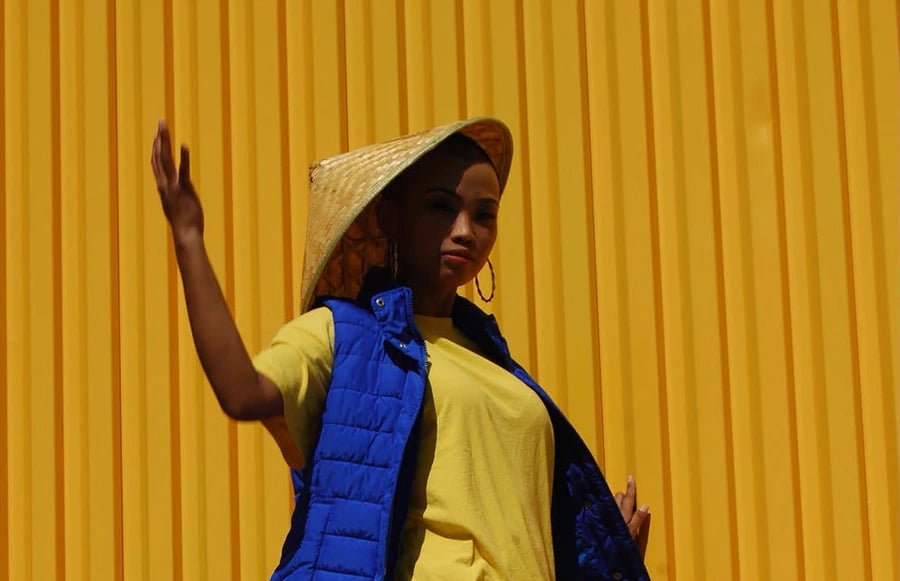Bright sunlight can be seen as a photography hindrance, similar to night photography. We were also taught that a bright, direct sun would be a complete nuisance to use while taking photographs. And, I'm here to tell you that we can turn that negative into a positive! Do not fret if those bright sunny rays are pounding down during a photoshoot session. With a few tweaks here and there, you can still capture a great photograph.
Best Camera Settings for Sunny Day:
- Set your camera to "M" (Manual) mode
- Lower your ISO to 100
- Set your shutter speed between 1/100 - 1/250
- Close your aperture to f/16
- Shoot in RAW
- Choose an "Auto" White Balance (you can always change it later in post)
Typically, bright sunlight can make your model squint, or you will get a complete whiteout. Photography 101 says to have your back against the light to get that pretty glow. Speaking of Photography 101, what else does it say about sunlight? Well...
Golden Hour: Ahh, good ol' golden hour. This happens twice a day and is just one hour before sunset and then again after sunset. You will get more shadows and warmer lights during these hours, and your bright sunlight shouldn't bother you during this golden hour.
We wrote an entire article dedicated to this topic, you can read it here: Golden Hour - The Key to Better Golden Hour Photography
Shade: Shade will always be your friend. Shade is caused by trees, buildings, or any object blocking the sun. If you don't see any, make some! You can MacGyver shade with an umbrella or even use some of our products on B&C Camera!
Editing: Editing will help immensely when shooting during those sunny days. And, you may need to edit on the heavy side. During post-production, you can enhance the colors and fix the brightness. You can also try a black and white edit to give an artistic edge.
We wrote an entire article dedicated to this topic, you can read it here: How to Edit RAW Images in Photoshop
Camera Settings: Proper settings will also lend you a hand while dealing with a bright sun. So. here is the settings rundown:
- ISO: Typically, you will set your camera ISO to low levels for low light situations. This is done to prevent noise in your photos. However, with a bright sun, noise is usually the least of your problems during a bright sunny day. Experiment with lower ISO settings.
- Shutter Speed: You do not want your shutter speed to be open for too long. The longer the shutter is open, the more light you allow in.
- White Balance: You can choose an Auto White Balance if you are not confident in your abilities. Or, if you can take the time to experiment, shoot manual and try different things!
- Aperture: You will keep your aperture setting smaller since you aren't in a low light condition. The lower the f/stop, the wider. So we will need a high f/stop number.
Sunny 16: The Sunny 16 rule has been around for so long. Long before digital photography and light meters. Lucky for you, your camera has a built-in light meter to help calculate the settings for you. If you opt-out of the aperture and shutter priority modes and decide to go manual, use the Sunny 16 rule. Using this rule will prevent your camera from basing its settings on reflected light.
For this rule, you will set your aperture to f/16, shutter speed to 1/100, and ISO to 100. You can experiment after that, but these settings are your best bet to start off with, especially if you are switching light conditions quickly.
Reflectors: Reflectors are smart investments when shooting in bright sunlight. Here are some of our reflectors at B&C Camera: Popular Reflectors
The purpose of photography reflectors is to reflect light and point the light towards darkness. Reflectors can also keep shadows away.
Reflectors also come in a variety of sizes and colors. Different reflector colors will come in handy for different moods.
- White is the most neutral and best when you don't want to change the color of someone's clothing (think of a bride).
- Silver is another neutral color but will offer more brightness.
- Gold will give you warmer tones with a bronzed look.
- Blue will offer up cooler tones.
- Translucent reflectors are best to filter out harsh light.
Lens Hoods: A lens hood almost acts like a baseball cap. It will attach to your lens and act as a deterrent to the sun and unwanted glares. Here is a link to our lens hoods at B&C Camera: Popular Lens Hoods
Safety: As always, safety first. The sun is gorgeous, warm, and makes most people feel good the minute they step into its rays. However, the sun is also dangerous. Always use sunblock, bring water to stay hydrated, and bring a pair of sunglasses.
Choose sun to be your friend, not your foe. Think of all tips and tricks above to execute the best photographs in bright sunlight. For more photography tips, check out our other articles!
Related article: What is Bracketing in Photography
Related article: Camera Settings for Cloudy Day
Related article: How to Photograph Lightning - 10 Steps
Related article: Best Camera Settings for Outdoor Portraits












